Guilin
Guilin (Standard Zhuang: Gveilinz; alternatively romanized as Kweilin) is a prefecture-level city in the northeast of China's Guangxi Zhuang Autonomous Region. It is situated on the west bank of the Li River and borders Hunan to the north. Its name means "Forest of Sweet Osmanthus", owing to the large number of fragrant sweet osmanthus trees located in the region. The city has long been renowned for its scenery of karst topography.
Guilin
桂林市 • Gveilinz Si Kweilin | |
|---|---|
 Scenery of Guilin | |
 Location of Guilin City jurisdiction in Guangxi | |
 Guilin Location in China | |
| Coordinates (Guilin Central Square (桂林中心广场)): 25°16′30″N 110°17′46″E | |
| Country | People's Republic of China |
| Autonomous region | Guangxi |
| Area | |
| • Total | 27,809 km2 (10,737 sq mi) |
| Elevation | 153 m (502 ft) |
| Population (2010)[1] | |
| • Total | 4,747,963 |
| • Density | 170/km2 (440/sq mi) |
| Time zone | UTC+8 (China Standard) |
| Postal code | 541XXX |
| Area code(s) | 0773 |
| ISO 3166 code | CN-GX-03 |
| License plate prefixes | 桂C for Guilin's city proper, Yangshuo, and Lingui; all others 桂H |
| Website | www |
| Guilin | |||||||||||||||||||||||||||||
|---|---|---|---|---|---|---|---|---|---|---|---|---|---|---|---|---|---|---|---|---|---|---|---|---|---|---|---|---|---|
"Guìlín" in Chinese characters | |||||||||||||||||||||||||||||
| Chinese name | |||||||||||||||||||||||||||||
| Chinese | 桂林 | ||||||||||||||||||||||||||||
| Hanyu Pinyin | Guìlín | ||||||||||||||||||||||||||||
| Postal | Kweilin | ||||||||||||||||||||||||||||
| Literal meaning | "Sweet Osmanthus Forest" | ||||||||||||||||||||||||||||
| |||||||||||||||||||||||||||||
| Zhuang name | |||||||||||||||||||||||||||||
| Zhuang | Gveilinz | ||||||||||||||||||||||||||||
| 1957 orthography | Gveilinƨ | ||||||||||||||||||||||||||||
Guilin is one of China's most popular tourist destinations,[2] and the epithet "By water, by mountains, most lovely, Guilin" (山水甲天下)[3] is often associated with the city. The State Council of China has designated Guilin a National Famous Historical and Cultural City, doing so in the first edition of the list.
History
Relics found in the city's Baojiyan (simplified Chinese: 宝积岩; traditional Chinese: 寶積巖) and Zengpiyan (甑皮巖) caves date back to approximately 10,000 years ago. The Zengpiyan people had a matriarchal clan society. Before the Qin dynasty, Guilin region was settled by the Baiyue people.[4] In 314 BC, a small settlement was established along the banks of the Li River.[5]
During the Qin dynasty's (221–206 BC) campaigns against the state of Nanyue, the first administration was set up in the area around Guilin.[6] The modern city was located within the Guilin Commandery, which is origin of the modern name "Guilin".
In 111 BC, during the reign of Emperor Wu of the Han dynasty, Shi'an County (simplified Chinese: 始安县; traditional Chinese: 始安縣) was established, which could be regarded as the beginning of the city.
In AD 507, the town was renamed Guizhou (Gui Prefecture, 桂州).[4]
In 634, Lingui County was established at the modern site of Guilin, under Gui Prefecture. In 868, Pang Xun rebelled against the Tang from Gui Prefecture.[4]
Guilin prospered in the Tang and Song dynasties but remained a county. The city was also a nexus between the central government and the southwest border, and it was where regular armies were placed to guard that border. Canals were built through the city so that food supplies could be directly transported from the food-productive Yangtze plain to the farthest southwestern point of the empire.
In 997, Guangnan West Circuit, predecessor of modern Guangxi, was established, with Guizhou as the capital. In 1133, Guizhou was renamed Jingjiang Prefecture (simplified Chinese: 静江路; traditional Chinese: 靜江路). In 1367, the name was changed to Guilin Prefecture (桂林府).[4]
In 1921, Guilin became one of the headquarters of the Northern Expeditionary Army led by Sun Yat-sen.[7]
In 1940, Guilin City was established.[8][9]
In 1950, the provincial capital of Guangxi was moved from Guilin to Nanning.
In 1981, Guilin was listed by the State Council as one of the four cities (the other three being Beijing, Hangzhou and Suzhou) where the protection of historical and cultural heritage, as well as natural scenery, should be treated as a priority project.[10][11]
Administrative divisions


Guilin administers seventeen county-level divisions, including 6 districts, 8 counties, 2 autonomous counties, and 1 county-level city.
- District:
- Xiufeng District (秀峰区)
- Xiangshan District (象山区)
- Diecai District (叠彩区)
- Qixing District (七星区)
- Yanshan District (雁山区)
- Lingui District (临桂区)
- County-level city:
- Lipu city (荔浦市)
- County:
- Yangshuo County (阳朔县)
- Lingchuan County (灵川县)
- Xing'an County (兴安县)
- Quanzhou County (全州县)
- Yongfu County (永福县)
- Ziyuan County (资源县)
- Guanyang County (灌阳县)
- Pingle County (平乐县)
- Autonomous county:
- Gongcheng Yao Autonomous County (恭城瑶族自治县)
- Longsheng Various Nationalities Autonomous County (龙胜各族自治县)
| Map |
|---|
Geography
Guilin is located in northern Guangxi, bordering Liuzhou to the west, Laibin to the southwest, Wuzhou to the south, Hezhou to the southeast, and within neighbouring Hunan, Huaihua to the northwest, Shaoyang to the north, and Yongzhou to the east. It has a total area of 27,809 square kilometres (10,737 sq mi). The topography of the area is marked by karst formations. The karsts surrounding Guilin are made of Triassic era limestone and dolomite rocks. The Li River flows through the city.
- Hills and mountains: Diecai Hill (叠彩山), Elephant Trunk Hill, Wave-Subduing Hill (伏波山), Lipu Mountains, Kitten Mountain, the highest peak of Guangxi, and Yao Hill (尧山)
- Caves: Reed Flute Cave, Seven-star Cave
Climate
Guilin has a monsoon-influenced humid subtropical climate (Köppen Cfa, bordering on Cwa), with short, mild winters, and long, hot, humid summers. Winter begins dry but becomes progressively wetter and cloudier. Spring is generally overcast and often rainy, while summer continues to be rainy though is the sunniest time of year. Autumn is sunny and dry. The monthly 24-hour average temperature ranges from 8.1 °C (46.6 °F) in January to 28.2 °C (82.8 °F) in July, and the annual mean is 19.12 °C (66.4 °F). The annual rainfall is just under 1,890 mm (74 in), and is delivered in bulk (~50%) from April to June, when the plum rains occur and often create the risk of flooding. With monthly percent possible sunshine ranging from 14% in March to 53% in September, the city receives 1,487 hours of bright sunshine annually.
| Climate data for Guilin, 1981−2010 normals, extremes 1951−2010 | |||||||||||||
|---|---|---|---|---|---|---|---|---|---|---|---|---|---|
| Month | Jan | Feb | Mar | Apr | May | Jun | Jul | Aug | Sep | Oct | Nov | Dec | Year |
| Record high °C (°F) | 27.6 (81.7) |
32.8 (91.0) |
33.7 (92.7) |
35.6 (96.1) |
35.4 (95.7) |
37.4 (99.3) |
39.5 (103.1) |
39.4 (102.9) |
38.5 (101.3) |
35.2 (95.4) |
31.4 (88.5) |
27.6 (81.7) |
39.5 (103.1) |
| Average high °C (°F) | 11.6 (52.9) |
13.3 (55.9) |
16.9 (62.4) |
23.2 (73.8) |
27.5 (81.5) |
30.5 (86.9) |
32.7 (90.9) |
33.0 (91.4) |
30.6 (87.1) |
25.9 (78.6) |
20.5 (68.9) |
15.1 (59.2) |
23.4 (74.1) |
| Daily mean °C (°F) | 8.1 (46.6) |
9.9 (49.8) |
13.3 (55.9) |
19.0 (66.2) |
23.3 (73.9) |
26.4 (79.5) |
28.2 (82.8) |
28.2 (82.8) |
25.6 (78.1) |
21.1 (70.0) |
15.8 (60.4) |
10.6 (51.1) |
19.1 (66.4) |
| Average low °C (°F) | 5.7 (42.3) |
7.6 (45.7) |
10.8 (51.4) |
16.1 (61.0) |
20.2 (68.4) |
23.5 (74.3) |
24.9 (76.8) |
24.7 (76.5) |
22.2 (72.0) |
17.7 (63.9) |
12.5 (54.5) |
7.4 (45.3) |
16.1 (61.0) |
| Record low °C (°F) | −4.9 (23.2) |
−3.6 (25.5) |
0.0 (32.0) |
4.0 (39.2) |
10.7 (51.3) |
13.0 (55.4) |
18.2 (64.8) |
18.3 (64.9) |
12.9 (55.2) |
6.1 (43.0) |
0.7 (33.3) |
−3.3 (26.1) |
−4.9 (23.2) |
| Average precipitation mm (inches) | 65.7 (2.59) |
99.2 (3.91) |
136.9 (5.39) |
217.8 (8.57) |
324.5 (12.78) |
395.2 (15.56) |
232.2 (9.14) |
147.4 (5.80) |
82.2 (3.24) |
66.8 (2.63) |
73.1 (2.88) |
46.8 (1.84) |
1,887.8 (74.33) |
| Average precipitation days (≥ 0.1 mm) | 15.1 | 15.5 | 18.6 | 20.2 | 19.0 | 17.5 | 16.1 | 14.8 | 8.2 | 9.7 | 8.7 | 9.1 | 172.5 |
| Average relative humidity (%) | 73 | 75 | 79 | 80 | 79 | 81 | 79 | 77 | 72 | 68 | 67 | 66 | 75 |
| Mean monthly sunshine hours | 66.9 | 50.0 | 51.6 | 72.6 | 109.5 | 131.1 | 199.4 | 204.1 | 193.4 | 157.1 | 134.4 | 117.2 | 1,487.3 |
| Percent possible sunshine | 20 | 16 | 14 | 19 | 27 | 32 | 48 | 51 | 53 | 44 | 41 | 36 | 33 |
| Source: China Meteorological Administration (precipitation days and sunshine 1971–2000)[12][13] | |||||||||||||
Demographics
Economy
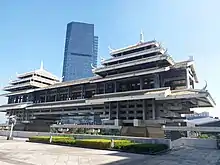
- The GDP per capita was ¥19435 (ca. US$2858) in 2009, ranked no. 125 among 659 Chinese cities.
- Local industries: condoms, pharmaceutical goods, tires, machinery, fertilizer, silk, perfume, wine, tea, cinnamon, herbal medicine
- Local agricultural products: Shatian Pomelo, summer orange, Fructus Momordicae, ginkgo, moon persimmon, Lipu Taro, Sanhua Alcohol, pepper sauce, fermented bean curd, Guilin Rice Noodle, water chestnut, grain, fish and dried bean milk cream in tight rolls
Until 1949 only a thermal power plant, a cement works, and some small textile mills existed as signs of industrialization in Guilin.[6] However, since the 1950s Guilin has added electronics, engineering and agricultural equipment, medicine, rubber, buses, textile and cotton yarn factories. Food processing, including the processing of local agricultural produce, remains the most important industry. More recent and modern industry features high technology, and the tertiary industry characterized by tourism trading and service.[15]
Transportation
Air
The airport is Guilin Liangjiang International Airport(ICAO:ZGKL, IATA:KWL). Airlines that fly to the airport are:
Rail
Guilin has the most high-speed rail stations out of all cities in China. There is Guilin North, Guilin West, Guilin and a new station in the Lingui District. Guilin station and Guilin North station are on the Hunan–Guangxi railway, Hengyang–Liuzhou intercity railway and Guiyang–Guangzhou high-speed railway, the main railways connecting Guangxi with central and southern China. Arriving at North station, high-speed trains between Guilin and Changsha and Beijing came into operation in December 2013. In December 2014, high-speed operations began connecting Guangzhou, Shenzhen, Guiyang, and Shanghai. This made it more convenient for people to come to Guilin. It takes only about 2 or 3 hours from Guangzhou to Guilin, 9 hours from Shanghai to Guilin and 13 hours from Beijing to Guilin.[16] Trains traveling between Kunming South and West Kowloon stations (for example) stop at Guilin West railway station.[17]
Urban
The city's public transportation includes bus routes and taxis. Guilin is the leading city in Mainland China operating double-decker buses regularly on major routes; in its main street the double-deckers run one-by-one almost every minute. Sightseeing boats also run on the city's canals and lakes.
Public colleges and universities
- Guilin University of Technology
- Guilin Medical University
- Guilin University of Electronic Technology
- Guangxi Normal University
- Guilin University of Aerospace Technology (桂林航天工业学院)
Note: Institutions without full-time bachelor programs are not listed.
Scenic spots
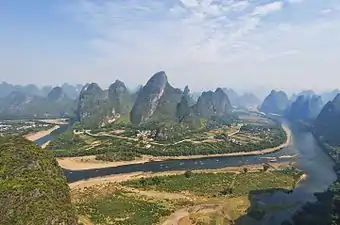 The Li River connects Guilin and Yangshuo County
The Li River connects Guilin and Yangshuo County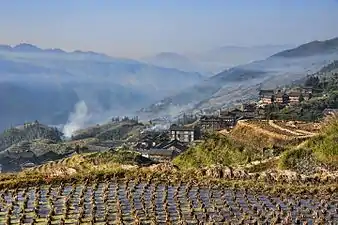 Longsheng Rice Terrace (Ping An)
Longsheng Rice Terrace (Ping An)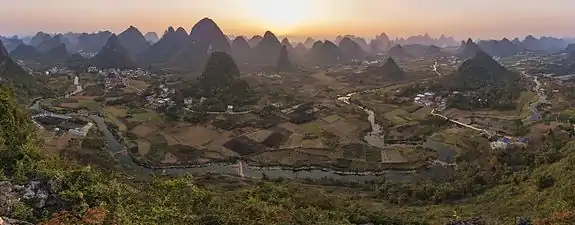 Cuiping Village
Cuiping Village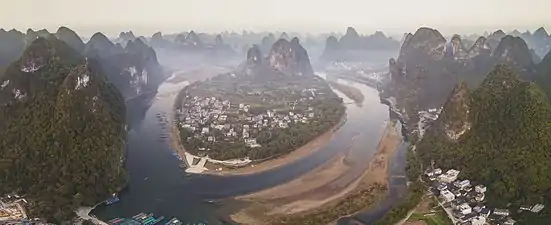 Xingping Village
Xingping Village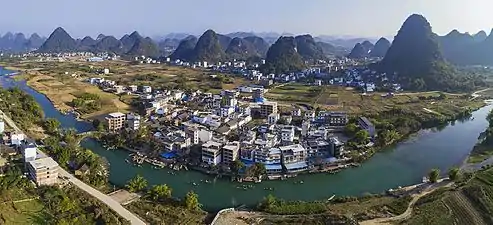 Rafts sailing down the Yulong River in Yangshuo, a county of Guilin
Rafts sailing down the Yulong River in Yangshuo, a county of Guilin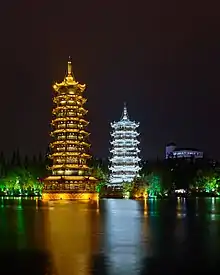 Sun and Moon Pagodas in Shan Lake
Sun and Moon Pagodas in Shan Lake Reed flute cave
Reed flute cave Scenic view on town from Seven-star Park
Scenic view on town from Seven-star Park
| Wikimedia Commons has media related to Guilin. |
Scenic spots around Guilin include:
- Jingjiang Princes City, a royal complex dating from the Ming Dynasty that lies near the center of modern Guilin
- Reed Flute Cave
- Silver Cave
- Li River
- Yangshuo
- Seven-star Cave and Seven Star Park[18] (七星公园)
- Camel Mountain (骆驼山) and Elephant Trunk Hill
- Piled Festoon Hill (堆花彩山)
- Crescent Hill (月牙山)
- Fubo Hill (伏波山)
- Nanxi Hill (南溪山)
- Erlang Gorge (二郎山峡谷)
- Huangbu (Yellow Cloth) Beach (黄埔滩)
- Moon Hill
- Longsheng Rice Terrace
- Daxu Ancient Town (大圩古市镇)
- Xingping Ancient Town (兴坪古镇)
- Duxiu (Solitary Beauty) Peak (独秀峰)
- Liusanjie Landscape Garden (刘三姐景观园)
- Yao Hill (尧山)
- Sun and Moon Pagodas (日月双塔)
Cuisine

Guilin cuisine is a mixture of Cantonese cuisine and Zhuang cuisine. It is known for its snacks and the use of spices, especially chili. Guilin chili sauce (桂林辣椒酱), used widely in cooking by locals, is made of fresh chili, garlic, and fermented soybeans, and is considered one of the city's Three Treasures (桂林三宝). The other two of the Three Treasures are Guilin Sanhua Jiu (桂林三花酒), a variety of rice baijiu, or liquor distilled from rice; and Guilin pickled tofu.
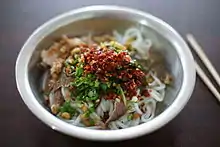
Guilin rice noodles have been the local breakfast staple since the Qin dynasty and are renowned for their delicate taste. Legend has it that when Qin troops suffering from diarrhea entered this region, a cook created the Guilin rice noodles for the army because they had trouble eating the local food. Specifically, the local specialty is noodles with horse meat, but this dish can also be ordered without the horse meat. Zongzi, a dumpling made from glutinous rice and mung bean paste wrapped in a bamboo or banana leaf is another popular delicacy in Guilin.
Quotes
- "I often sent pictures of the hills of Guilin which I painted to friends back home, but few believed what they saw."
- - Fan Chengda (Chinese Song Dynasty scholar)[19]
- "Guilin's scenery is best among all under heaven." (Chinese: 桂林山水甲天下; pinyin: Guìlín shānshuǐ jiǎ tiānxià)
- - popular Chinese saying[20]
International relations
Twin towns—Sister cities
Guilin is twinned with:
 - Nishikatsura, Yamanashi, Japan,[21]– Lingchuan County
- Nishikatsura, Yamanashi, Japan,[21]– Lingchuan County - Kumamoto City, Japan,[22]– Guilin
- Kumamoto City, Japan,[22]– Guilin - Toride City, Japan, – Guilin
- Toride City, Japan, – Guilin - Miho, Ibaraki, Japan- Lingui
- Miho, Ibaraki, Japan- Lingui - Jeju, South Korea
- Jeju, South Korea - Hastings, New Zealand
- Hastings, New Zealand - Toruń, Poland[23]
- Toruń, Poland[23] - Orlando, United States[24]
- Orlando, United States[24] - Tlaxcoapan, Hidalgo, Mexico[25]
- Tlaxcoapan, Hidalgo, Mexico[25] - Langkawi, Malaysia
- Langkawi, Malaysia
The Guilin relationship with the New Zealand city Hastings started in 1977, after a research scientist, Dr Stuart Falconer, identified a number of common areas of interest between the two cities, including horticulture and their rural-urban mix.[26] In 1997 Guilin commenced an exchange relationship with Ōta, Gunma, Japan.[27]
Notable residents
- Daniel Weihs (born 1942), Israeli Aeronautical Engineering professor at the Technion – Israel Institute of Technology
- Ou Hongyi (born 2002), climate activist
See also
- Bai Chongxi
- Chinese alcoholic beverage
- Li Zongren
References
- "Archived copy". Archived from the original on 22 May 2012. Retrieved 1 June 2012.CS1 maint: archived copy as title (link) China Census 2010
- Foster, Simon (2012). Frommer's China. John Wiley & Sons. pp. 612. ISBN 9781118223529.
- “桂林山水甲天下”之英译. China Daily (in Chinese). Retrieved 11 June 2019.
- 桂林概况. people.com.cn (in Chinese).
- "Cruise Through The Beautiful Scenery Of The Li River In Guilin". Discover China. Retrieved 25 January 2020.
- "Guilin (China) Encyclopædia Britannica". Encyclopædia Britannica (Online). Retrieved 11 July 2013.
- "Guilin never ceases to amaze". Retrieved 19 April 2016.
- "Archived copy". Archived from the original on 9 May 2012. Retrieved 18 March 2013.CS1 maint: archived copy as title (link)
- "Guilin History". Retrieved 19 April 2016.
- "Beijing Hotels 【 #1 Ranked Hotel in Beijing 】 - Nehow.com". Nehow.com. Retrieved 19 April 2016.
- "Guilin History". Retrieved 19 April 2016.
- 中国气象数据网 - WeatherBk Data (in Chinese). China Meteorological Administration. Retrieved 15 April 2020.
- 中国地面国际交换站气候标准值月值数据集(1971-2000年). China Meteorological Administration. Archived from the original on 21 September 2013. Retrieved 25 May 2010.
- https://worldpopulationreview.com/world-cities/guilin-population/
- "Guilin Economy; china Window". Retrieved 11 July 2013.
- "High-speed Trains Available in Guilin" ChinaTour.Net Accessed 2014-12-29
- "G314 timetable" Accessed 2019-02-12
- "Guilin Tours - Best Tour Packages For Guilin, China in 2019". Discover China. Retrieved 25 January 2020.
- "Guilin Tours, Guilin Tour Packages, China Travel Agency". Retrieved 19 April 2016.
- "Learn Chinese, Study Chinese, Language, Study in China, Travel in China, Guilin". Retrieved 19 April 2016.
- "Archived copy" (PDF). Archived from the original (PDF) on 24 September 2015. Retrieved 1 November 2014.CS1 maint: archived copy as title (link)
- "Kumamoto International Foundation". Retrieved 19 April 2016.
- "Miasta bliźniacze Torunia" [Toruń's twin towns]. Urząd Miasta Torunia [City of Toruń Council] (in Polish). Retrieved 22 August 2013.
- "Archived copy". Archived from the original on 12 April 2013. Retrieved 18 March 2013.CS1 maint: archived copy as title (link)
- "Tlaxcoapan se hermana con Guilin, China". Retrieved 19 April 2016.
- "Hastings-Guilin Sister City relationship". Archived from the original on 23 March 2010. Retrieved 19 April 2016.
- 中華人民共和国広西壮族自治区桂林市 [Guilin, Guangxi Zhuang Autonomous Region, China] (in Japanese). Retrieved 20 June 2016.
Further reading
- "Guilin (China")—Britannica Online Encyclopedia
External links
| Wikimedia Commons has media related to Guilin. |
| Wikivoyage has a travel guide for Guilin. |
- Guilin Government Official website (in Chinese)
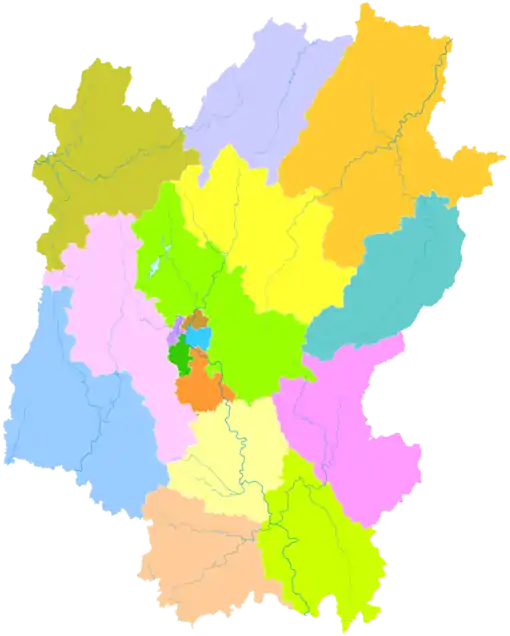
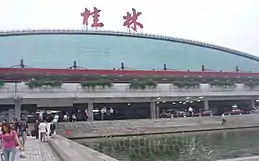
.jpg.webp)
